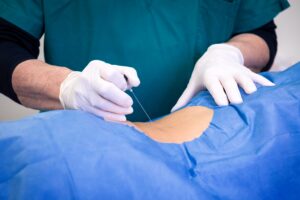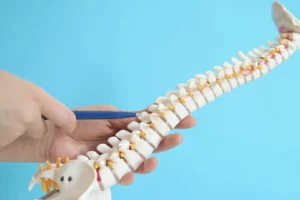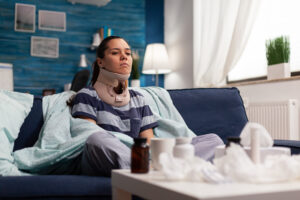Cervical radiculopathy, commonly known as a “pinched nerve” in the neck, is a condition that can cause significant discomfort and limitation in one’s daily activities. This condition arises when a nerve in the neck is compressed or irritated at the point where it branches away from the spinal cord. Understanding the various cervical radiculopathy treatments available is critical for those seeking relief from this debilitating condition.
Understanding Cervical Radiculopathy
Cervical radiculopathy typically results from degenerative changes in the spine, such as herniated discs or bone spurs, that put pressure on the nerves. Symptoms vary depending on the affected nerve but often include pain, numbness, and weakness in the neck, shoulder, arm, or hand. These symptoms can cause discomfort and also drastically impact an individual’s ability to perform everyday tasks.
Diagnosis of Cervical Radiculopathy
Accurate diagnosis is crucial in determining the most effective treatment plan for cervical radiculopathy. The diagnostic process typically involves several steps.
Medical History and Symptoms Review
The initial step in diagnosing cervical radiculopathy involves a detailed discussion of the patient’s medical history and symptoms. Healthcare professionals inquire about the nature, duration, and intensity of pain, as well as any instances of neck injury or activities that may have contributed to the condition. Questions about symptoms such as numbness, tingling, weakness, or any radiating pain from the neck to the arms and hands are crucial for an accurate diagnosis.
Physical Examination
During the physical examination, the healthcare provider assesses the neck’s range of motion, muscle strength, reflexes, and sensitivity to touch in different areas. Specific tests, like the Spurling test, may be conducted. This involves gently turning and applying pressure to the head to replicate or relieve symptoms, thereby helping to identify the affected nerve root.
Diagnostic Imaging
X-rays: These are often the first imaging tests done. They can reveal areas of the spine where the nerves may be pinched due to spinal degeneration, such as bone spurs or arthritis.
Magnetic Resonance Imaging (MRI): MRI is particularly valuable in diagnosing cervical radiculopathy as it provides detailed images of soft tissues, including nerves and the spinal cord. An MRI can show if a herniated disc or other tissue is pressing on a nerve.
Computed Tomography (CT) Scan: In cases where an MRI is not available or advisable, such as the patient having metal implants, claustrophobia, or is pregnant, a CT scan can be used. It gives a detailed view of the bony structures of the spine and can help identify bone spurs or other potential causes of nerve compression.
Nerve Conduction Studies and Electromyography (EMG): These tests measure the electrical activity of nerves and muscles. They can confirm the diagnosis of radiculopathy and also help to rule out other conditions that might mimic its symptoms, like peripheral neuropathy.
Differential Diagnosis
Healthcare professionals need to differentiate cervical radiculopathy from other conditions that can cause similar symptoms, such as carpal tunnel syndrome or peripheral neuropathy. A thorough diagnostic process helps ensure that the treatment plan addresses the actual underlying issue.
Consultation with Specialists
In some cases, patients may be referred to specialists such as neurologists or orthopedic surgeons for further evaluation and treatment recommendations.
Non-Surgical Treatments for Cervical Radiculopathy
Non-surgical treatments are often the first course of intervention for cervical radiculopathy and can be highly effective in managing and alleviating symptoms.
Physical Therapy and Exercises
Custom Exercise Programs: A physical therapist can design a personalized exercise program to strengthen the neck muscles, which helps support the cervical spine and alleviate pressure on the nerves.
Flexibility and Stretching: Stretching exercises can help to maintain and improve the flexibility of the neck, reducing stiffness and increasing range of motion.
Posture Training: Patients are taught to focus on proper posture, especially during activities that may strain the neck, to prevent further aggravation of symptoms.
Manual Therapy: Techniques such as soft tissue massage, gentle mobilization, and traction can help relieve pain and improve neck function.
Medications and Pain Management
NSAIDs: Non-steroidal anti-inflammatory drugs, such as ibuprofen or naproxen, are commonly used to reduce inflammation and alleviate pain.
Oral Corticosteroids: For more severe cases, a short course of oral corticosteroids may be prescribed to decrease inflammation and pain.
Epidural Steroid Injections: In cases where severe pain persists, epidural steroid injections may be recommended. These injections deliver steroids directly to the area around the spinal nerves, providing significant pain relief.
Muscle Relaxants: These medications can be used to relieve muscle spasms, which are often associated with cervical radiculopathy.

Surgical Options for Cervical Radiculopathy
Surgical intervention may become necessary for cervical radiculopathy when non-surgical treatments do not provide adequate relief or if neurological symptoms such as weakness or loss of coordination progress. The two most common surgical procedures for this condition are:
Anterior Cervical Discectomy and Fusion (ACDF)
This surgery involves accessing the cervical spine through a small incision in the front of the neck. The surgeon removes the damaged disc (discectomy) that is pressing on the nerve or spinal cord. After the disc is removed, the space is filled with a bone graft or a synthetic material. This helps the adjacent vertebrae to eventually fuse, or grow together, stabilizing that segment of the spine. Recovery from ACDF varies, with many patients returning to normal activities within several weeks. Fusion of the vertebrae may take several months. This procedure has a high success rate in relieving radiculopathy symptoms and preventing recurrence.
Cervical Artificial Disc Replacement
In this procedure, the surgeon removes the diseased disc, similar to ACDF. Instead of fusing the vertebrae, a specialized artificial disc is inserted into the space to preserve motion at the disc space. The primary advantage of this procedure is the maintenance of neck mobility. By avoiding fusion, the artificial disc allows for a more natural range of motion. Recovery times may be shorter compared to fusion surgery, and patients often report a quicker return to normal activities. Patients need to discuss with their surgeon whether artificial disc replacement is suitable for their specific condition.
Lifestyle Modification for Prevention of Cervical Radiculopathy
While cervical radiculopathy can be a challenging condition, there are several effective strategies for preventing its onset or reducing the risk of recurrence.
Maintaining Good Posture
Good posture involves aligning the ears over the shoulders with the chest open and the shoulders back. This alignment reduces the stress on the cervical spine. Being mindful of posture while sitting, standing, and even sleeping is crucial. For instance, when using a smartphone or tablet, keep the device at eye level instead of bending the neck forward. Using ergonomic chairs and supportive pillows can help maintain proper posture, especially during prolonged periods of sitting or sleeping.
Regular Exercise
Incorporating exercises that strengthen the neck, shoulders, and upper back can support the cervical spine. Strong muscles provide better stability and reduce the likelihood of strain. Regular stretching also helps to maintain neck flexibility, which is essential for preventing stiffness and strain. Yoga and pilates are excellent for improving flexibility and core strength.
If those activities are too much, walking, swimming, or cycling also helps to improve overall fitness and healthy weight maintenance, which reduces the burden on the spine.
Ergonomic Workspace
With the rise of work-from-home jobs, most of us spend the majority of our time seated at a desk, looking at a computer screen. The top of your monitor should be at eye level, while your keyboard and mouse are within easy reach, and your arms and elbows rest comfortably at your sides. An ergonomic chair that supports the natural curve of the spine is important. The feet should rest flat on the floor or the footrest. Finally, make sure to take short breaks every hour to stand, stretch, or walk. This change in position helps alleviate neck tension and strain.
When to Consult a Specialist
Consulting a specialist for cervical radiculopathy should be considered if you experience persistent pain despite home treatments, or if the pain intensifies. Loss of coordination or balance issues, as well as neurological symptoms such as burning sensations, electric shock-like feelings, or altered reflexes, are significant signs of potential nerve compression in the cervical spine. These symptoms, especially if they interfere with daily activities, work, or sleep quality, necessitate seeking medical advice. Early consultation with specialists like orthopedic surgeons, neurologists, or physiatrists can facilitate an accurate diagnosis and effective treatment plan, improving the chances of a successful recovery.

Find Relief with Our Tailored Cervical Radiculopathy Treatments
Experience unparalleled spine care at The Institute for Comprehensive Spine Care, led by Dr. Gbolahan Okubadejo, MD, FAAOS, a top spine surgeon in New Jersey and New York. Our practice is committed to delivering personalized treatment options and compassionate care. Whether you’re grappling with spinal pain or seeking to improve your spinal health, our wide range of services is tailored to meet your unique needs. Our team understands the impact of spinal issues on your life and is dedicated to providing you with the best care, education, and support. Don’t let spinal pain limit your life. Schedule your consultation today and take the first step towards a brighter, pain-free future with Dr. Bo and The Institute for Comprehensive Spine Care.
Cervical Radiculopathy FAQs
What is cervical radiculopathy?
Cervical radiculopathy occurs when a nerve in the neck is compressed, leading to pain and other symptoms in the arm.
What causes cervical radiculopathy?
Cervical radiculopathy causes include age-related degeneration, herniated discs, bone spurs, spinal stenosis, injury, and poor posture.
Are there exercises that help with cervical radiculopathy?
Yes, specific neck and shoulder exercises can strengthen muscles and alleviate symptoms.
Can cervical radiculopathy be cured without surgery?
Many cases can be effectively managed with non-surgical treatments like physical therapy and medications.
How can I prevent cervical radiculopathy?
Maintaining good posture, regular exercise, and ergonomic workstations can help prevent it.
















